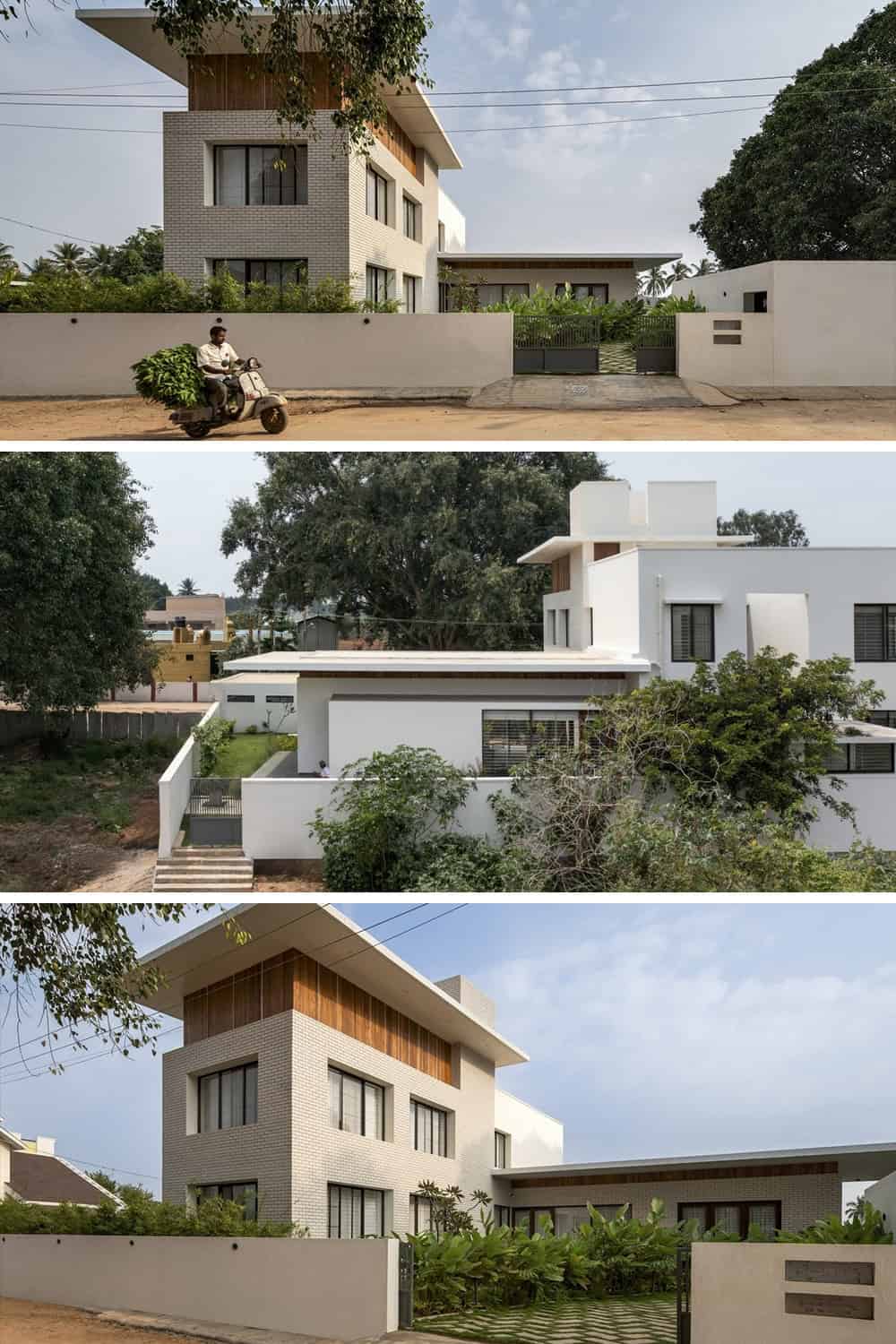Project: The Modern Pastoral House
Architects: Sudaiva Studio
Location: Yenagunte, India
Area: 6,000 sf
Year: 2023
Photographs by: Shamanth Patil J
In the heart of rural Bengaluru, our design-build endeavor seamlessly marries agrarian pragmatism with architectural elegance. Committed to Vastu Shastra principles, the modest four-bedroom dwelling unfolds on an 8,260-square-foot plot, flanked by sacred peepul trees and the revered Lakshmi Narasimha Swamy Temple. Embracing these natural and cultural treasures, our L-configured design captures panoramic views and integrates with the surroundings.
The 6,000-square-foot floor plan harmoniously blends contemporary and mid-century modern influences, featuring a glass façade, overhanging cantilever roofs, and recycled teak wood panels reminiscent of the temple’s chariot design. A lush tropical garden, strategically placed water features, and indigenous materials contribute to a tranquil oasis, making the residence not only a haven for its agriculturist owner but also a village landmark, bridging architecture and ritual in shared beauty.


Catering to an agriculturist’s needs, our design-build project in rural Bengaluru began with a simple brief: to design a modest, four-bedroom dwelling for his extended family, following Vastu Shastra principles, on a south-facing 8,260-square-foot plot adjoining his farm. Upon our initial visit to the site, we were immediately captivated by two prominent features: the majestic peepul (Sacred Fig) trees located to the south and east of the plot and the revered Lakshmi Narasimha Swamy Temple, situated directly across from the site. The setting held immense potential for creating a serene sanctuary nestled amidst these natural and cultural landmarks.
Our design aimed to embrace and frame views of these elements, drawing inspiration from the surrounding environment to integrate both the natural beauty and the cultural heritage into the architecture. Once the client understood our vision, he was persuaded and granted us full creative freedom to proceed with the design. The architectural plan took shape as an L-configuration, oriented to capture views of the trees and the temple. The parking shed is positioned separately in the southeast corner of the property. Guests are welcomed by a winding walkway through a lush tropical garden leading to the main entrance located at the property’s rear, a placement determined by Vastu Shastra principles.
The floor plan, spanning a total built area of 6,000 square feet, includes an open-plan living and dining space that seamlessly integrates with the outdoors through a glass façade. Extending from this area is an outdoor deck designed to harmonize with the natural landscape. It appears to float above the adjacent pond, an organically shaped water body bordered with boulders sourced locally. The remaining spaces are positioned to maximize views of the landscape through expansive openings. This includes a mezzanine level in the son’s bedroom, which offers an elevated perspective akin to a belvedere. The landscaping complements the home’s rectangular shape and is strategically laid out to offer both seclusion and views.
The built form blends contemporary design with mid-century modern influences, characterized by flat planes, glass, and horizontal lines. Overhanging cantilever roofs not only provide shade but also add a distinctive architectural feature. The structure’s tranquility is enhanced by white brick cladding, contrasted against the modernity of large, sleek aluminum windows. A key feature of the design is the recycled teak wood panels placed atop both the ground and first-floor volumes, drawing inspiration from the intricate design of the top section of the temple’s chariot. In the mezzanine area, these panels are crafted to open fully on two sides, enhancing natural ventilation throughout the space.
The interior flooring, incorporating natural Indian stones like Kota and Jaisalmer, adds an organic beauty and regional character to the house. The choice of materials reflects both durability and aesthetic appeal, aligning with the home’s overall design ethos. While relaxing on the deck, the client often encounters temple-goers drawn in by the house’s captivating presence. This dynamic has elevated the home to a village landmark, inviting and engaging visitors in the shared beauty of architecture and ritual.
This website uses cookies.